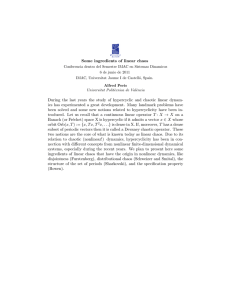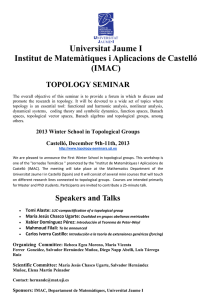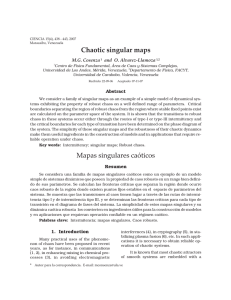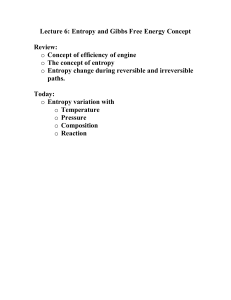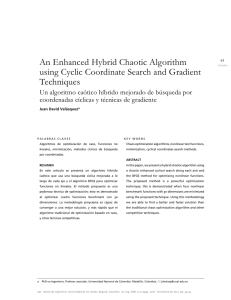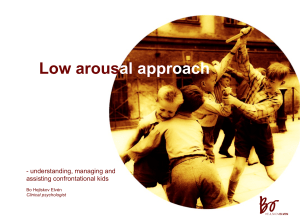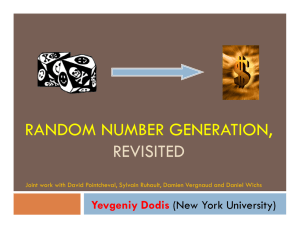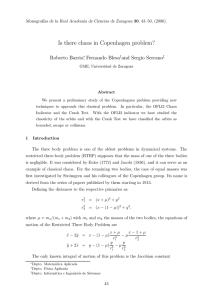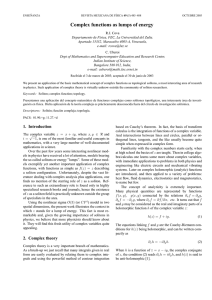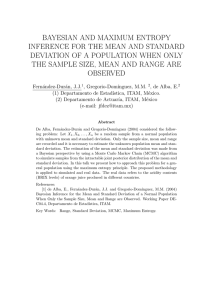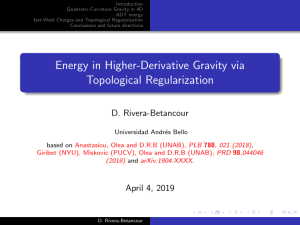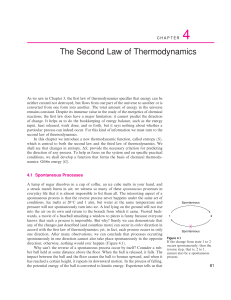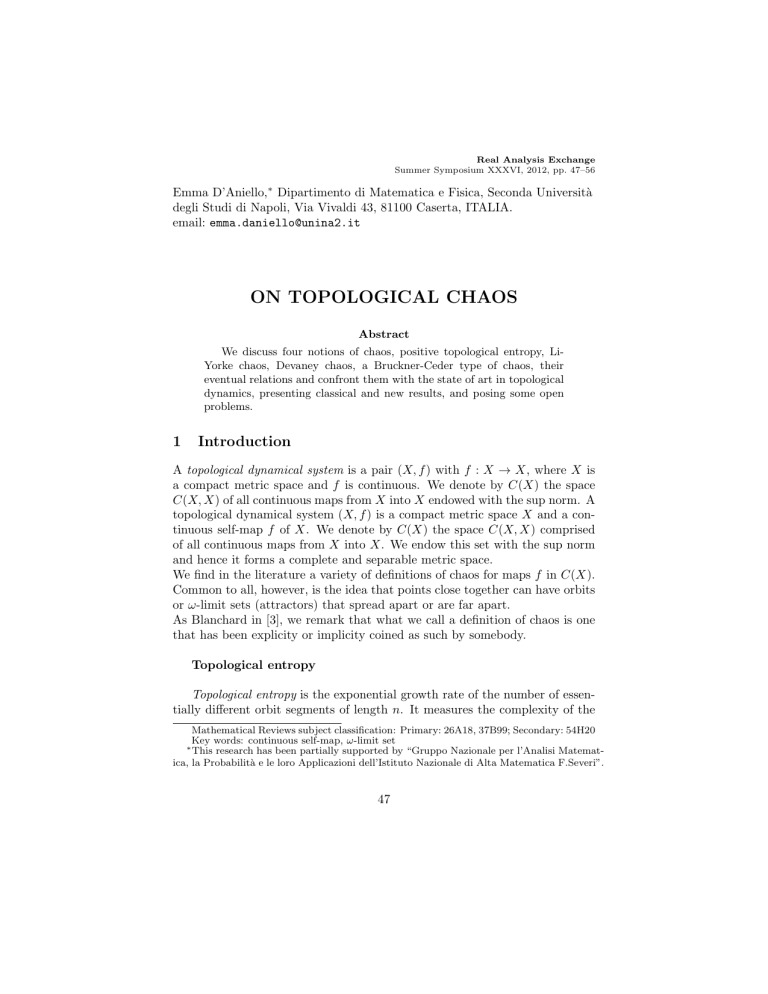
Real Analysis Exchange Summer Symposium XXXVI, 2012, pp. 47–56 Emma D’Aniello,∗ Dipartimento di Matematica e Fisica, Seconda Università degli Studi di Napoli, Via Vivaldi 43, 81100 Caserta, ITALIA. email: [email protected] ON TOPOLOGICAL CHAOS Abstract We discuss four notions of chaos, positive topological entropy, LiYorke chaos, Devaney chaos, a Bruckner-Ceder type of chaos, their eventual relations and confront them with the state of art in topological dynamics, presenting classical and new results, and posing some open problems. 1 Introduction A topological dynamical system is a pair (X, f ) with f : X → X, where X is a compact metric space and f is continuous. We denote by C(X) the space C(X, X) of all continuous maps from X into X endowed with the sup norm. A topological dynamical system (X, f ) is a compact metric space X and a continuous self-map f of X. We denote by C(X) the space C(X, X) comprised of all continuous maps from X into X. We endow this set with the sup norm and hence it forms a complete and separable metric space. We find in the literature a variety of definitions of chaos for maps f in C(X). Common to all, however, is the idea that points close together can have orbits or ω-limit sets (attractors) that spread apart or are far apart. As Blanchard in [3], we remark that what we call a definition of chaos is one that has been explicity or implicity coined as such by somebody. Topological entropy Topological entropy is the exponential growth rate of the number of essentially different orbit segments of length n. It measures the complexity of the Mathematical Reviews subject classification: Primary: 26A18, 37B99; Secondary: 54H20 Key words: continuous self-map, ω-limit set research has been partially supported by “Gruppo Nazionale per l’Analisi Matematica, la Probabilità e le loro Applicazioni dell’Istituto Nazionale di Alta Matematica F.Severi”. ∗ This 47 48 E. D’Aniello orbit structure of a dynamical system ([8], [13]). Let (X, d) be a compact metric space and f ∈ C(X). For each n ∈ N, define on X the metric dn as dn (x, y) = max{d(f i (x), f i (y)) : 0 ≤ i < n}. The metric dn measures the maximum distance between the first n iterates of x and y. Fix > 0. A subset E of X is said to be (n, , f )-separated if any two distinct points of E are at least apart in the metric dn . Denote by N (n, , f ) the maximum cardinality of an (n, , f )-separated set. The topological entropy of the map f is defined by 1 ent(f ) = h(f ) = lim lim sup log N (n, , f ) . →0 n→∞ n (For equivalent definitions of entropy, see [6]. The topological entropy is either a finite non-negative number or +∞. There are dramatic differences between dynamical systems with zero topological entropy and dynamical systems with positive topological entropy. Example 1.1. The topological entropy of an isometry is 0. Example 1.2. [6] The topological entropy of the shift map σ is a positive number. Definition 1.3. (Topological conjugation) Let X and Y be metric spaces, and let f : X → X and g : Y → Y be continuous maps. The maps f and g are said to be topologically conjugate if there exists a homeomorphism h : X → Y such that (h ◦ f )(x) = (g ◦ h)(x), ∀x ∈ X. Properties of topological entropy: 1. Topological entropy is an invariant of topological conjugacy. 2. The topological entropy of a continuous map f : X → X does not depend on the choice of a particular metric generating the topology of X. 3. h(f m ) = mh(f ), ∀m ∈ N. 4. If f is invertible, then h(f −1 ) = h(f ). Hence h(f m ) = |m|h(f ) for all m ∈ Z. 49 On topological chaos 5. If f ∈ C(X), g ∈ C(Y ), with X = (X, dX ) and Y = (Y, dY ) metric spaces, then (a) h(f × g) = h(f ) + h(g), (b) if g is a factor of f (or, equivalently, f is an extension of g), then h(f ) ≥ h(g). N Example 1.4. Let X = (2N ) , f : X → X s.t. f (α(1), α(2), . . .) = (σ(α(1)), σ(α(2)), . . .) (α(i) ∈ 2N , ∀i ∈ N). Then h(f ) = ∞. Li-Yorke chaos A subset S of X containing at least two points is called a scrambled set if for any x, y in S with x 6= y, lim sup |f n (x) − f n (y)| > 0 n→∞ and lim inf |f n (x) − f n (y)| = 0, n→∞ that is, x and y have orbits that get arbitrarily close to each other but infinitely often they are at a distance greater than some positive . A map f is said to be Li-Yorke chaotic if it has un uncountable scrambled set. Remark 1.5. On the unit interval the existence of a two points scrambled set implies the existence of an uncountable scrambled chaos (see, among others, [19]). Remark 1.6. As the definition of Li-Yorke chaos relies on the behaviour of joint orbits, independently on what occurs in the neighbourhood, it is a partial property. Theorem 1.7. [4] Let X be a compact matric space and let f ∈ C(X). Then h(f ) > 0 ⇒ f is Li-Yorke-chaotic 50 E. D’Aniello Devaney chaos Sensitivity: sensitive dependence on initial conditions A map f has sensitive dependence on initial conditions if there is s > 0 such that for all x ∈ X and > 0 one can find y with d(x, y) < and n ∈ N such that d(f n (x), f n (y)) ≥ s. (Minor changes in the initial state lead to dramatically different long-term behavior.) On the unit interval, originally, this definition was introduced by Guckenheimer with the requirement that the sensitivity hold on a set of positive Lebesgue measure. The definition used later by other authors is the one above, that extends to all metric spaces and does not contain probabilistic assumption. On the unit interval sensitivity ⇒ positive topological entropy ⇒ Li-Yorke chaos Transitivity We say that f is topologically transitive if there is a point x whose forward orbit is dense. If X has no isolated points this condition is equivalent to the existence of a point whose ω-limit set is the all of X. Proposition 1.8. Let f ∈ C(X). Suppose that for any non-empty open sets U and V there is n ∈ N such that f n (U ) ∩ V 6= ∅ (i.e. f is topologically mixing). Then f is topologically transitive. Remark 1.9. The converse is not true: an irrational circle rotation is topologically transitive but not topologically mixing. Properties: 1. On infinite X, transitivity, dense P (f ) ⇒ sensitivity. 2. Transitivity, h(f ) > 0 ⇒ sensitivity. 3. f transiive and not sensitive ⇒ f has equicontinuity points. 4. Minimality without equicontinuity ⇒ sensitivity. On topological chaos 51 5. On S 1 , transitivity, P (f ) 6= 0 ⇒ sensitivity. 6. On S 1 , transitivity, not conjugate to irrational rotation ⇒ sensitivity. 7. On I, transitivity ⇒ h(f ) > 0. 8. On I, transitivity ⇒ P (f ) dense. 9. On S 1 , ∃ transitive homeomorphism. 10. On I and R, @ transitive homeomorphism. 11. X countable ⇒ no transitive map. 12. X countable ⇒ no sensitive map. 13. X with isolated points ⇒ no sensitive map. Devaney chaos Devaney introduced his own definition of chaos (“89”). Originally, the definition was as follows: a map f ∈ C(X) is chaotic in Devaney sense if the following conditions hold: 1. (X, f ) is transitive; 2. the set of periodic points of f is dense in X; 3. f has sensitive dependence on initial conditions. It is a well-known result that conditions (1) and (2) imply (3) ([1] (X metric); [14] (X compact metric)). Definition 1.10. f is chaotic on a subsystem in Devaney sense if there is a perfect subset K of X such that f (K) = K and f |K , the restriction of f to K, is Devaney chaotic. Theorem 1.11. ([16], [18]) f Devaney chaotic ⇒ f Li-Yorke chaotic Theorem 1.12. On the unit interval 1. f chaotic in the sense of Devaney ⇔ transitivity, and 52 E. D’Aniello 2. f chaotic on a subsystem in the sense of Devaney m h(f ) > 0 Remark 1.13. In the general contest of a compact metric space X there is no relation between Devaney chaos and positive topological entropy. Example 1.14. [10] The shift map is Devaney chaotic. A Bruckner-Ceder type of chaos On the unit interval In (Chaos in terms of the map x 7→ ω(x, f ), Pacific J. Math., “92”), Bruckner and Ceder address directly the idea that points arbitrarily close together can have ω-limit sets that are far apart. They furnish the family of ω-limit sets of a continuous function with the Hausdorff metric and ask questions related to the continuity of the map ωf : x 7→ ω(x, f ). They find that ωf is rarely continuous and they obtain several characterization of continuity for ωf . In particular, Theorem 1.15. ωf is continuous if and only if each ω-limit set for f has cardinality 1 or 2. Phrasing the questions in terms of the Baire class of ωf , they obtain, among other properties, the results conerning continuity as corollaries, and a notion of chaos strictly between Li-Yorke and positive entropy. Precisely, they prove that h(f ) > 0 ⇒ ωf not Baire 1 ⇒ f is Li-Yorke chaotic. So, f ∈ C(I) is said to be Bruckner-Ceder chaotic if ωf is not of Baire class 1. Some facts about Borel and Baire maps Theorem 1.16. [7] For function from [0, 1] into (K([0, 1]), H) the Borel class and the Baire class agree for finite ordinals. 53 On topological chaos Remark 1.17. As Baire 1 maps can be characterized as those f whose restriction to any nonempty perfect set P has a point of continuity, we have that, in particular, for f ∈ C(I), ωf is Borel 1 m the restriction to any perfect P 6= ∅ has a point of continuity. Questions: Is the previous theorem true in the general setting of X a compact metric space? Even just in the special case of the map ωf : X → K(X), x 7→ ω(x, f ), (f ∈ C(X)), are Baire and Borel property equivalent for finite ordinals? Is it true that ωf is Borel 1 if and only if the restriction to any nonempty perfect set P has a point of continuity? On a compact metric space X Theorem 1.18. [11] Let f ∈ C(X). Then ωf : X → K(X), x 7→ ω(x, f ), is of Baire class 2. Theorem 1.19. [11] Let f ∈ C(X) with f chaotic in the sense of Devaney. Then, either 1. ωf is everywhere discontinuous, or 2. ωf is continuous precisely on the set {x ∈ X : ω(x, f ) = X}. Example 1.20. [11] The shift map σ on n symbols is such that ωσ is everywhere discontinuous. Questions: What could be a generalization of the definition of Brucker-Ceder chaos from I to X? (i) ωf not of Borel class 1? or (ii) the existence of a perfect subset such that the restriction of ωf to it has no point of continuity? And how would it be related to the other notions of chaos? 54 E. D’Aniello Example 1.21. [15] There exists f ∈ C(X), with X Cantor set, such that h(f ) > 0 and X is minimal so that ωf is constant. Example 1.22. [10] There exists f ∈ C(X), with X Cantos set, such that f is Devaney chaotic, h(f ) = ∞ and ωf is everywhere discontinuous. Example 1.23. [11] There exists f ∈ C(X), with X Cantos set, such that f is Li-Yorke chaotic, h(f ) = 0 and ωf is everywhere continuous as ω(x, f ) = X, for every x ∈ X. Example 1.24. [11] There exists f ∈ C(X), with X Cantos set, such that h(f ) = ∞, ωf is everywhere discontinuous and f has no periodic point, hence it is not Devaney chaotic. Remark 1.25. Hence, in the general setting h(f ) > 0 ; ωf somewhere discontinuous Remark 1.26. Glasner and Weiss have proved that ∃K ⊆ Σ2 s.t. h(σ|K ) = 0 and σ|K is Devaney chaotic. Hence, by joint result with T.H. Steele, ω(σ|K ) is everywhere discontinuous. Therefore, in the general setting, ωf everywhere discontinuous ; h(f ) > 0. Question: What if X is not a Cantor space? These examples (counter-examples) hold (live) on the Cantor space! Generic (typical) behavior On the unit interval Theorem 1.27. The set of all f ∈ C(I) with h(f ) = ∞ is a dense Gδ subsets of C(I), that is the typical f ∈ C(I) has positive topological entropy. As “f is Devaney chaotic on a subsystem ⇔ h(f ) > 0 ⇒ f is Bruckner-Ceder chaotic ⇒ f is Li-Yorke chaotic”, the following hold Corollary 1.28. The typical f ∈ C(I) is Devaney chaotic on a subsystem. Corollary 1.29. The typical f ∈ C(I) is Bruckner-Ceder chaotic. Corollary 1.30. The typical f ∈ C(I) is Li-Yorke chaotic. On topological chaos 55 Question: What about the general contest of X a compact metric space? What about the cases X a Cantor space and X an n-dimensional manifold? Theorem 1.31. [20] The generic f ∈ C(M ), where M is an n-dimensional manifold, possesses a horse-shoe like structure. Corollary 1.32. [11] Positive topological entropy, Devaney chaos on a subsystem, Li-Yorke chaos are all present on a dense and open set of functions in C(M ). Corollary 1.33. [11] The typical f ∈ C(M ) has the property that ωf is everywhere discontinuous on a subsystem. Remark 1.34. The situation is completely different on the Cantor space! In fact: Theorem 1.35. [10] The typical element of C(2N ) has zero topological entropy and is Devaney chaotic on no subsystem K contained in 2N . Theorem 1.36. [2] The typical element of C(2N ) has no Li-Yorke pair. Proposition 1.37. [11] The set {f ∈ C(2N ) : ωf is everywhere discontinuous on a subsystem} is dense in C(2N ). Theorem 1.38. [11] ωf is continuous for the generic self-map f of the Cantor space. References [1] J. Banks, J. Brooks, G. Cairns, G. Davis, P. Stacey, On Devaney definition of chaos, Amer. Math. Monthly, Vol. 99 (1992), pp. 332–334. [2] N.C. Bernardes, Jr., U.B. Darji, Graph theoretic structure of maps of the Cantor space, 2012, submitted.??? [3] F. Blanchard, Topological chaos: what does this mean?, J. Difference Equ. Appl., Vol. 15 (2009), n. 1, pp. 23-46. [4] F. Blanchard, E. Glasner, S. Kolyada, A. Maass, On Li-Yorke pairs, J. Reine Angew. Math., Vol. 547 (2002), pp. 51–68. [5] L.S. Block, W.A. Coppel, One-Dimensional Dynamics, Lecture Notes in Math., Vol. 1513, Springer-Verlag, Berlin, 1992. 56 E. D’Aniello [6] M. Brin, G. Stuck, Introduction to Dynamical Systems, Cambridge University Press, 2004. [7] A.M. Bruckner, J. Ceder, Chaos in terms of the map x 7→ ω(x, f ), Pacific J. Math., Vol. 156 (1992), n. 1, pp. 63–96. [8] R. Bowen, Entropy for group endomorphisms and homogeneous spaces, Trans. Amer. Math. Soc., Vol. 153 (1971), pp. 401–414. [9] M. Brin, G. Stuck, An Introduction to Dynamical Systems, Cambridge University Press, 2004. [10] E. D’Aniello, U.B. Darji, Chaos among self-maps of the Cantor space, J. Math. Anal. Appl., Vol. 381 (2011), pp. 781–788. [11] E. D’Aniello, T.H. Steele, Chaos and the map x 7→ ω(x, f ), submitted, 2012. [12] R. Devaney, Chaotic Dynamical Systems, Addison-Wesley, Reading MA, 1989. [13] E.I. Dinaburg, The relation between topological entropy and metric entropy, Dokl. Akad. Nauk SSSR, Vol. 190 (1970), pp. 19–22 (Soviet Math. Dokl. 11 (1969), pp. 13–16). [14] E. Glasner, B. Weiss, Sensitive dependence on initial conditions, Nonlinearity, Vol. 6 (1993), pp. 1067–1075. [15] C. Grillenberger, Constructions of strictly ergodic systems. I. Given entropy., Z. Wahrscheinlichkeitstheorie und Verw. Gebiete, Vol. 25 (1972/73), pp. 323-334. [16] W. Huang, X. Ye, Devaney’s chaos or 2-scattering implies Li-Yorkes chaos, Topology and its Applications, Vol. 117 (2002), pp. 259–272. [17] T.Y. Li, J.A. Yorke, Period three implies chaos, Amer. Math. Monthly, Vol. 82 (1975), n. 10, pp. 985-992. [18] Jie-hua Mai, Devaney’s chaos implies existence of s-scrambled sets, Proc. Amer. Math. Soc., Vol. 132 (2004), n. 9, pp. 2761–2767. [19] S. Ruette, Chaos for continuous interval maps - a survey of relationship between the various sorts of chaos, preprint, 2003. [20] K. Yano, A remark on the topological entropy of homeomorphisms, Invent. Math., Vol. 59 (1980), n. 3, pp. 215-220.
